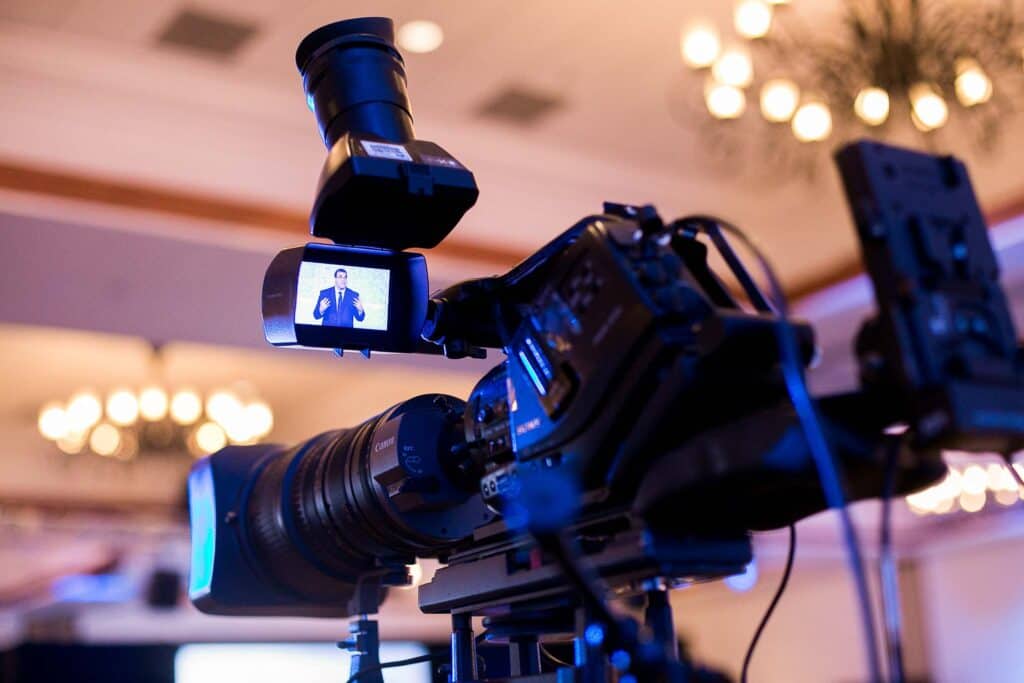How audio visual charlotte nc strengthens live-streamed meetings
Wiki Article
Understanding the Inclusion of Audio Visual Technology in Today's Educational Environments
The integration of audio-visual modern technology in educational setups has changed the training and discovering process. Educators now have access to devices that satisfy various discovering styles, enhancing student interaction and partnership. However, the unification of these technologies provides both possibilities and obstacles. Comprehending just how to properly implement these tools is important. What techniques can instructors use to optimize the benefits of audio-visual technology in their classrooms?The Development of Audio-Visual Technology in Education And Learning
As educational requirements progressed over the decades, audio-visual innovation undertook significant changes that reshaped the discovering setting. Tools such as film projectors and slide shows were the main means of incorporating visual components into class. These early technologies offered educators with the capability to present details dynamically, yet they were limited in ease of access and interactivity.With the development of videotape recorder in the 1970s, class started to include recorded lessons, widening the extent of educational sources. The introduction of desktop computers in the 1980s additional transformed this landscape, permitting the development of multimedia presentations and interactive understanding experiences.
The increase of the internet in the 1990s noted a zero hour, allowing real-time access to a wide range of audio-visual products. Today, electronic tools such as interactive whiteboards and on the internet understanding systems proceed to improve the instructional experience, cultivating interaction and cooperation amongst learners.
Benefits of Audio-Visual Equipment for Diverse Knowing Styles
Audio-visual tools play an important function in satisfying varied understanding styles by improving aesthetic discovering and improving auditory involvement. By integrating pictures, videos, and audio, these innovations create a more comprehensive academic setting. This multifaceted strategy permits instructors to resolve the varied preferences and requirements of trainees successfully.Enhancing Visual Learning
Engagement in the discovering process is noticeably enhanced through making use of audio-visual tools, satisfying various discovering styles. These tools, such as video clips, infographics, and interactive presentations, give aesthetic stimuli that help comprehension and retention. Aesthetic students, specifically, take advantage of the incorporation of pictures and computer animations, which can streamline complex principles and enhance understanding. Additionally, audio-visual sources can show real-world applications, making finding out more appropriate and engaging. By integrating shade, motion, and noise, instructors can create a dynamic learning environment that records students' interest and fosters much deeper cognitive links. Inevitably, the strategic use audio-visual innovation not just supports aesthetic knowing but additionally improves the general educational experience for diverse learners.Improving Auditory Engagement
A considerable benefit of integrating audio-visual tools in education is their capability to improve auditory involvement among pupils. These tools, which incorporate multimedia discussions, podcasts, and interactive audio aspects, satisfy numerous finding out styles, specifically benefiting auditory students (audio visual charlotte nc). By incorporating audio and narration, teachers can create immersive experiences that catch trainees' attention and strengthen understanding. This involvement is essential, as it cultivates a much deeper understanding of the material and advertises retention. Furthermore, audio-visual devices can help with joint knowing environments, motivating pupils to take part in discussions and share their understandings. Ultimately, the incorporation of audio-visual modern technology not only sustains acoustic interaction yet additionally improves the overall academic experience, making discovering more vibrant and effective for all pupilsEnhancing Involvement With Interactive Discovering

Gamification components, such as tests and simulations, can improve inspiration and retention, making discovering a lot more pleasurable and reliable. These methods not only promote cognitive interaction yet also accommodate diverse knowing styles, making sure that all pupils can take part meaningfully. As a result, interactive understanding settings promote a feeling of area and belonging, inevitably resulting in enhanced scholastic results. With the combination of audio aesthetic modern technology, teachers can change standard class right into lively areas where trainees flourish and proactively form their educational journeys.
Connecting Theory and Experiment Multimedia Resources
Multimedia resources function as a critical link in between theoretical ideas and sensible application in educational settings. By improving involvement, promoting collective learning experiences, and sustaining diverse understanding designs, these devices produce a much more inclusive and vibrant knowing environment - audio visual charlotte nc. This method not only promotes much deeper understanding however likewise prepares pupils for real-world challenges
Enhancing Engagement With Multimedia
Interaction in academic setups substantially enhances when instructors include multimedia resources into their training approaches. Making use of video clips, podcasts, and interactive discussions improves the discovering experience, permitting pupils to link with the product on numerous levels. Multimedia sources deal with different finding out styles, supplying aesthetic, acoustic, and kinesthetic stimulations that can hold pupils' attention better than traditional lecture approaches. Additionally, these sources can simplify complex ideas, making them extra obtainable and memorable. By incorporating multimedia, educators can create a dynamic class setting that cultivates inquisitiveness and motivates learners. Eventually, the strategic use audio-visual modern technology serves to bridge the void between academic knowledge and practical application, improving the instructional experience for both trainers and pupils.Facilitating Collaborative Understanding Knowledge
Many researches indicate that collective learning experiences significantly enhance pupil end results when incorporated with multimedia sources. Multimedia tools help with communication amongst pupils, allowing them to engage in analytic and essential thinking collectively. By utilizing video clip conferencing, collaborative platforms, and interactive discussions, instructors create atmospheres for teamwork and shared learning. These innovations allow trainees to interact their ideas effectively and obtain immediate comments, fostering a deeper understanding of the subject. On top of that, multimedia sources can provide complicated concepts in even more absorbable formats, advertising discussion and collaboration. Therefore, the mix of joint knowing and audio-visual modern technology not only improves the educational experience but likewise prepares trainees for real-world team effort dynamics, stressing the relevance of cooperation and collective understanding building and construction.Supporting Diverse Discovering Styles
While traditional mentor approaches often provide to a limited variety of discovering preferences, the combination of audio-visual technology uses an extra inclusive technique to education and learning. By utilizing multimedia resources such as video clips, interactive simulations, and digital discussions, educators can resolve different finding out designs, including visual, acoustic, and kinesthetic. This versatility enables for differentiated instruction, making it possible for pupils to engage with material in ways that resonate with their private choices. Furthermore, audio-visual devices can assist in much deeper understanding by offering multiple depictions of complicated ideas. As an outcome, pupils that may fight with standard techniques can find alternative paths to success, promoting an extra equitable discovering atmosphere that sustains scholastic success for all students.Obstacles in Implementing Audio-Visual Technology
Although audio-visual modern technology holds excellent guarantee for enhancing educational experiences, its execution typically runs into substantial difficulties. One primary worry is the monetary worry linked with getting and keeping such tools, which can strain spending plans, especially in underfunded organizations. Additionally, inadequate training for educators can hinder reliable combination, leaving them ill-prepared to use the modern technology completely. Technical concerns, such as software application breakdowns and compatibility troubles, may likewise disrupt lessons and annoy both educators and students. Additionally, differing levels of student accessibility to modern technology outside the classroom can develop variations in learning chances. Ultimately, the capacity for over-reliance on modern technology may diminish crucial mentor approaches, eventually restricting the educational experience. Attending to these difficulties calls for an extensive strategy, including sufficient funding, expert development, and fair access to resources, to guarantee that audio-visual technology can be leveraged successfully in today's instructional settings.Best Practices for Integrating Modern Technology in the Class

Furthermore, cultivating an interactive atmosphere through joint devices motivates student interaction and involvement. Utilizing varied audio-visual sources provides to different discovering designs, accommodating visual, auditory, and kinesthetic students. Frequently examining the influence of modern technology on student learning helps educators fine-tune their approaches and adjust to changing requirements. Ultimately, involving trainees in the choice of technology promotes possession and inspiration. By sticking to these finest methods, educators can develop a vibrant classroom environment that effectively incorporates technology and improves the educational experience for all trainees.
The Future of Audio-Visual Modern Technology in Education And Learning
As classrooms significantly accept innovation, the landscape of audio-visual tools in education and learning remains to evolve (audio visual charlotte nc). Future advancements are expected to focus on higher interactivity and customization, permitting teachers to customize finding out experiences to specific pupil needs. Technologies such as enhanced truth (AR) and online reality (VIRTUAL REALITY) will likely provide immersive learning environments, enhancing student involvement and understanding
Man-made intelligence (AI) is positioned to play a substantial duty in audio-visual technology by using real-time feedback and flexible learning paths. This integration may aid educators recognize and address student difficulties better. click here Cloud-based platforms will certainly help with simpler access to sources and collaboration among pupils and educators, despite place.
Along with these technical advancements, expert growth for instructors will be important, guaranteeing they are geared up to use these devices properly. Overall, the future of audio-visual modern technology in education promises to produce more dynamic, inclusive, and impactful discovering experiences.
Regularly Asked Questions
Exactly How Can Teachers Choose the Right Audio-Visual Devices for Their Class?
Selecting appropriate audio-visual tools calls for educators to analyze their academic objectives, take into consideration trainee demands, review available technology, and seek referrals from peers or experts, making certain devices effectively enhance understanding and engagement within their specific class atmosphere.What Spending plan Factors to consider Are There for Applying Audio-Visual Technology?
Spending plan factors to consider for carrying out audio-visual innovation include first acquisition costs, upkeep costs, training for staff, and potential software program licensing costs. Additionally, long-lasting investment in updates and substitutes ought to also be factored right into financial preparation.Are There Particular Training Resources for Teachers on Audio-Visual Tools?
Many institutions use training resources for teachers on audio-visual tools, consisting of on the internet courses, workshops, and educational guides. These sources aim to enhance educators' abilities and self-confidence in effectively incorporating modern technology into their training practices.Just how Do We Measure the Effectiveness of Audio-Visual Modern Technology in Discovering?
Gauging the efficiency of audio-visual modern technology in learning includes examining student involvement, comprehension, retention prices, and general academic efficiency. Surveys, evaluations, and empirical research studies can give valuable understandings right into its effect on academic end results.What Are Common Misconceptions Regarding Audio-Visual Modern Technology in Education?
Typical false impressions concerning audio-visual innovation in education and learning include the belief that it assures involvement and learning end results, along with the assumption that all students profit just as, overlooking specific learning preferences and requirements.Report this wiki page